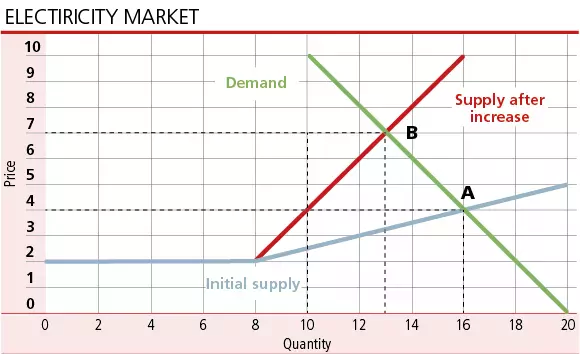Households and businesses have seen - or will see - a substantial increase in their electricity bills. While a subsidy does not solve the problem, targeted assistance can limit the burden without distorting behavior.
The sharp rise in profits of electricity generators has led to suspicions of abuse of market power. While such power necessarily leads to large profits, these can also be caused by other factors.
High margins are not a proof of abusive market power
To frame our analysis, the figure below shows a stylized representation of the market. The green line indicates demand. The supply before the crisis is given by the blue line. It consists of two segments, representing two types of producers. A moderate quantity can be produced by low-cost companies, such as hydroelectric resources. They can supply a quantity of 8 (all figures are indicative) and break even as long as the price is 2.

To produce more, other sources must be used, such as gas-fired power plants. The cost of producing each additional quantity increases, giving the right-hand side of the supply with a positive slope. Equilibrium is at point A with a price of 4 and a quantity of 16. Hydro producers have a unit margin of 2 (price of 4 minus cost of 2) for a total profit of 16. Gas producers have a profit of 8 (difference between the price and the blue line for quantities between 8 and 16). Consumers pay 64.
What happens if the price of gas rises? This does not affect the cost of hydroelectric production, so the left-hand side of the supply remains unchanged. The cost of production via gas-fired power plants, however, increases sharply. Producing above 8 quickly becomes very expensive, and the right-hand side of the supply becomes steeper, moving from the blue line to the red line. The new equilibrium is at point B with a price of 7 for a quantity of 13, i.e. a bill of 91 for consumers. This is great news for hydroelectric producers whose margin increases from 2 to 5, with a corresponding increase in their profits. The profits of gas producers increase from 8 to 12.5.
Is this market abuse? No. A key point of economic analysis is that the price is determined by the marginal producer, i.e. the one who brings the last unit to market. He has a cost of 7 and makes no profit. But since this price applies to everyone, the other producers benefit, simply by luck.
How to reduce the cost
The happiness of the producers is clearly the misfortune of the consumers. Should a subsidy be granted to the latter? This would not solve anything, because it would increase demand (moving the green line upwards) and the price, with the subsidy ultimately going to the producers. This point was developed in a previous post.
Should we give up? No, because there is a way to relieves consumers' finances, while still confronting them with the reality of more expensive electricity. It consists of granting a subsidy only on a part of the consumption. The figure below shows an example where consumers receive a subsidy of 3 for each of the first 10 units consumed, an amount corresponding to the hatched area. In other words, the price actually paid on these first units remains unchanged at 4. Beyond this quantity, consumers pay the full price, and thus have an incentive to save electricity. The market equilibrium remains at point B.

Beware of the specifics of implementation
What would this assistance look like in practice? As the bill of the consumers goes from 91 to 61, one could think that it is enough to grant a subsidy of 33%. Not at all! A subsidy in this form reduces by one third the cost of any single unit purchased, not just the first 10. This leads to the problem mentioned above, namely an increase in demand and price.
It is important that the amount received by consumers not be linked to the quantity they demand. The aid of 30 is paid regardless of the quantity used. In practical terms, each consumer could be given a lump sum for 2023 based on the amount of electricity consumed in 2021. In our example, the consumer pays 64 in the initial situation (point A). An aid of 50% of this consumption during the crisis period corresponds to the lump sum subsidy.
How to finance this? One possibility is to levy a tax on the profits of producers. In our example, it would affect above all the low-cost producers, who have the highest margin. To be very clear, this is not a punishment for abusive behavior by producers. It is simply a choice that those whose income increases simply by chance pay back part of the gain.

